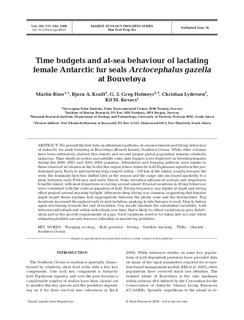| dc.description.abstract | We present the first data on attendance patterns, at-sea movements and diving behaviour of Antarctic fur seals breeding at Bouvetøya (Bouvet Island), Southern Ocean. While other colonies have been extensively studied, this remote and second largest global population remains relatively unknown. Time depth recorders and satellite relay data loggers were deployed on breeding females during the 2000–2001 and 2001–2002 summers. Attendance and foraging patterns were similar to those observed at colonies in the Scotia Sea region where Antarctic krill Euphausia superba is the predominant prey. Early to mid-lactation trips ranged within ~100 km of the island, usually towards the west; the dominant direction shifted later in the season and the range also increased markedly to a peak between early February and early March. Solar elevation influenced arrivals and departures from the island, with most departures occurring around sunset. Diurnal variations in diving behaviour were consistent with the vertical migration of krill. Diving frequency was higher at night and diving effort peaked around morning twilight. Afternoon deep diving was common, suggesting that females might target dense daytime krill aggregations between the photic zone and the thermocline. Trip durations increased throughout early to mid-lactation, peaking in late January to early March, before again decreasing towards the end of lactation. Our results illustrate the substantial variability, both between individuals and within individuals over time, that is likely to reflect variations in prey distribution and in the growth requirements of pups. Such variations need to be taken into account when estimating habitat use and resource utilisation in marine top predators. | no_NO |
